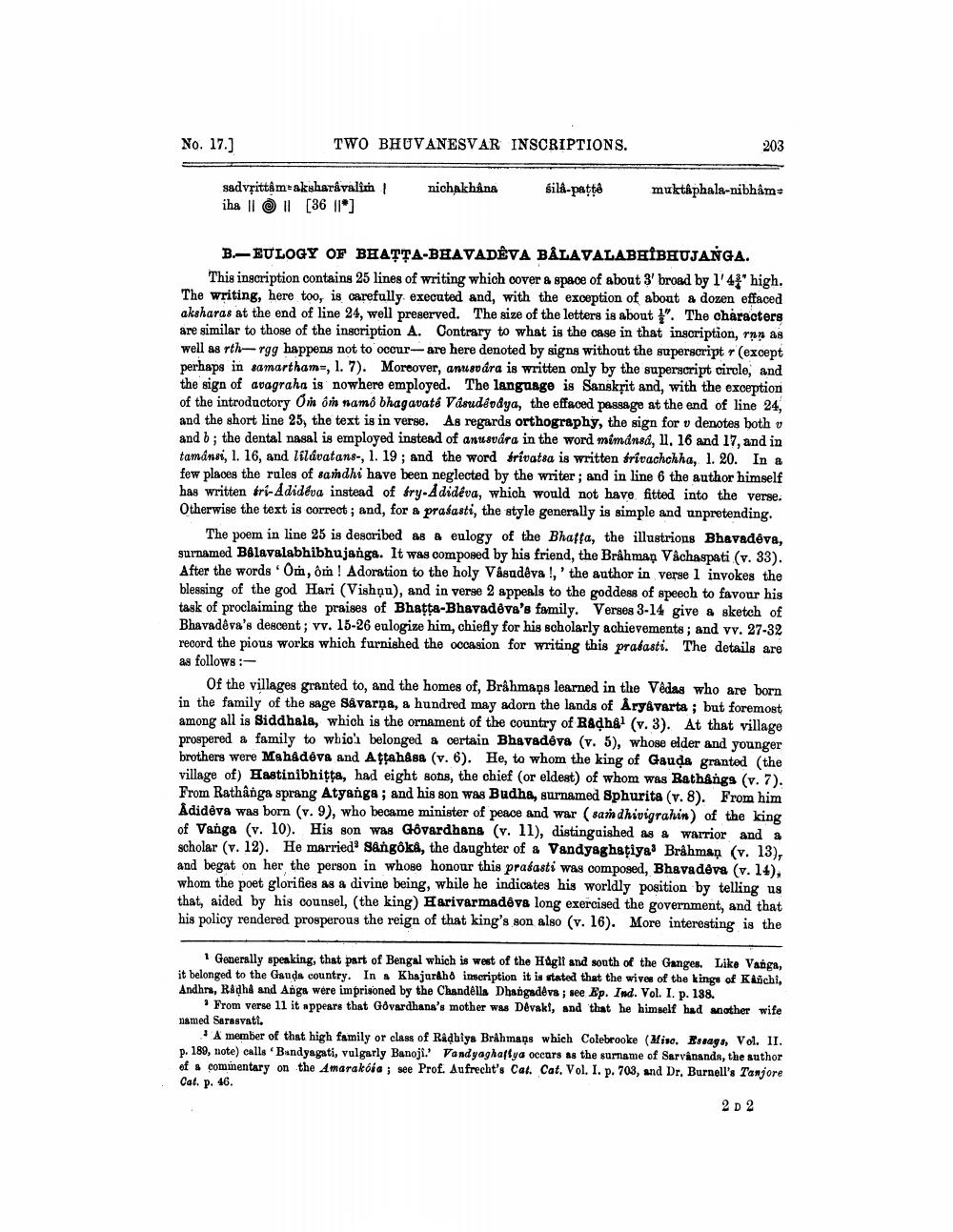________________
No. 17.)
TWO BHUVANESVAR INSCRIPTIONS.
203
nichakhana
sila-patte
muktaphala-nibhám
sadvșittâm-aksharâvalim iha Il © 11 [36 llo]
B-BULOGY OF BHATTA-BHAVADÊVA BÅLAVALABHIBHUJANGA.
This inscription contains 25 lines of writing which cover & space of about 3' broad by 1'4high. The writing, here too, is carefully executed and, with the exception of about a dozen effaced aksharas at the end of line 24, well preserved. The size of the letters is about 1". The characters are similar to those of the inscription A. Contrary to what is the case in that inscription, rnn as well as rth- rgg happens not to occur- are here denoted by signs without the superscript r (except perhaps in samartham-, 1. 7). Moreover, anusvára is written only by the superscript circle, and the sign of avagraha is nowhere employed. The language is Sanskrit and, with the exception of the introductory Om ôm samo bhagavaté Vasudeodya, the effaced passage at the end of line 24, and the short line 25, the text is in verse. As regards orthography, the sign for v denotes both v and b; the dental nasal is employed instead of antisvára in the word mimdnsá, 11, 16 and 17, and in tamânsi, 1. 16, and lilavatans-, 1. 19; and the word frivatsa is written frivachchha, 1. 20. In a few places the rules of samdhi have been neglected by the writer, and in line 6 the author himself has written fri-Adideva instead of fry-Adidéva, which would not have fitted into the verse. Otherwise the text is correct; and, for a prasasti, the style generally is simple and unpretending.
The poem in line 25 is described as a eulogy of the Bhafta, the illustrions Bhavadêva, surnamed BAlavalabhibhujanga. It was composed by his friend, the Brahman Váchaspati (v. 33). After the words Om, ôm ! Adoration to the holy Vasudeva !,' the author in verse 1 invokes the blessing of the god Hari (Vishịu), and in verse 2 appeals to the goddess of speech to favour his task of proclaiming the praises of Bhatta-Bhavadêva's family. Verges 3-14 give & sketch of Bhavadêva's descent; vv. 15-26 eulogize him, chiefly for his scholarly achievements; and vv. 27-32 record the pious works which furnished the occasion for writing this prasasti. The details are as follows:
Of the villages granted to, and the homes of, Brahmaps learned in the Vedas who are born in the family of the sage Såvarna, a hundred may adorn the lands of Årydvarta ; but foremost among all is Siddhala, which is the ornament of the country of Radhe (v. 3). At that village prospered a family to which belonged a certain Bhavadova (v. 5), whose elder and younger brothers were Mahadeva and Attahása (v. 6). He, to whom the king of Gauda granted (the village of) Hastinibhitta, had eight sons, the chief (or eldest) of whom was Rathångs (v.7). From Rathânga sprang Atyanga; and his son was Budha, surnamed Sphurita (v. 8). From him Ådideva was born (v. 9), who became minister of peace and war (samdhivigrahin) of the king of Vanga (v. 10). His son was Govardhana (v. 11), distinguished as a warrior and a scholar (v. 12). He married' sångôka, the daughter of a VandyagheţiyaBråhman (v. 13), and begat on her the person in whose honour this prasasti was composed, Bhavadeva (v.14). whom the poet glorifies as a divine being, while he indicates his worldly position by telling us that, aided by his counsel, (the king) Harivarmadêva long exercised the government, and that his policy rendered prosperous the reign of that king's son also (v. 16). More interesting is the
Generally speaking, that part of Bengal which is west of the Haglt and south of the Ganges. Like Varga, it belonged to the Gauda country. In Khajuraho inscription it is stated that the wives of the kings of Kávchi, Andhra, Radha and Angs were imprisoned by the Chandella Dhangadhvs; see Ep. Ind. Vol. I. p. 188.
From verse 11 it appears that Govardhana's mother was Dévakl, and that he himself had another wife named Sarasvati.
. A member of that high family or class of Radhiya Brahmans which Colebrooke (Mino. Essags, Vol. II. p. 189, note) calls Bandyagati, vulgarly Banoji. Vandyaghaflya occurs as the surname of Sarvånands, the author of a commentary on the Amarakóia; see Prof. Aufrecht's Cat. Cat. Vol. I. p. 703, and Dr. Burnell's Tanjore Cat. p. 46.
2D 2




